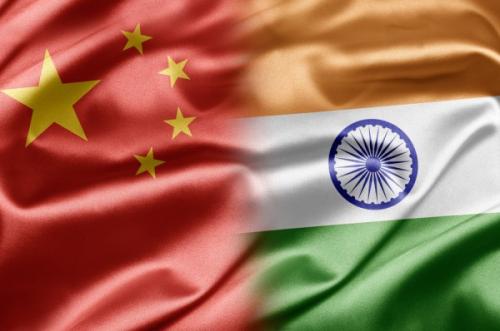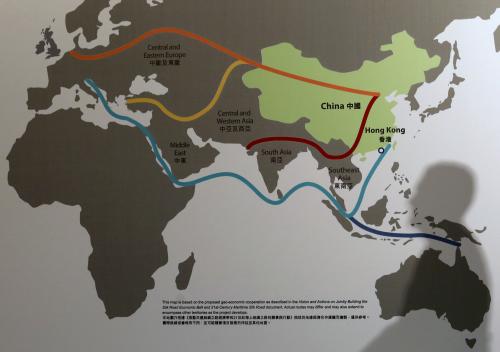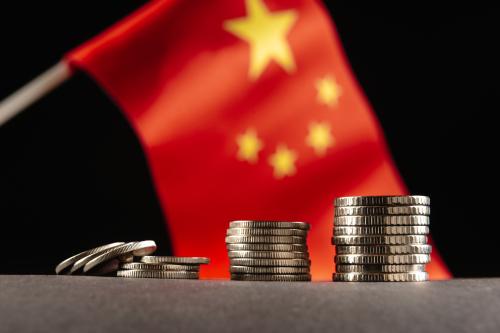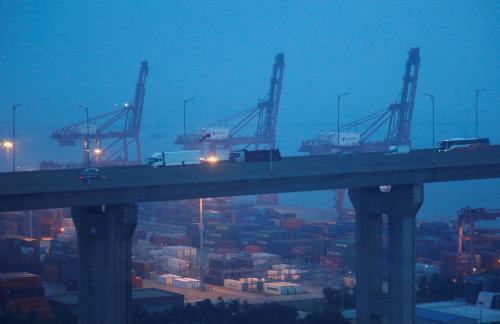Jamie Horsley examines China’s approach to Belt and Road, in particular investigating how Chinese authorities have responded to a spectrum of fiscal, environmental, social, and political risk concerns relating to Chinese overseas investment. She explores China’s promises for green and sustainable development and greater transparency, the actions and policies already undertaken, and what else is needed to deliver on such promises. This piece originally appeared in Foreign Policy.
China’s far-flung, ambitious Belt and Road Initiative has hit some potholes and roadblocks during its first five years of evolution. As domestic credit tightens and troubled overseas projects proliferate, China’s four biggest infrastructure lenders reportedly made no loans to the Asian region in the first three months of 2019.
But the Belt and Road Initiative is not going away—not least because it’s the signature foreign-policy initiative of Chinese Communist Party leader Xi Jinping, so deeply associated with his rule that it was enshrined in the CCP charter in November 2017.
As world leaders prepare to convene in Beijing for the second international Belt and Road forum at the end of April, pressure is building domestically and overseas for China to overhaul its initial laissez-faire approach to Belt and Road project financing and implementation. Responding to a spectrum of fiscal, environmental, social, and political risk concerns about Chinese overseas projects, Chinese authorities are calling for “high-standard” and “high-quality” Belt and Road cooperation, and they are reportedly compiling a list of officially acknowledged projects and drafting rules to govern them.
Prior to the Italian agreement signed last month, China reported a total of 171 intergovernmental cooperative undertakings with over 150 countries and international organizations under Belt and Road, trade in goods with countries along the Belt and Road exceeding $7 trillion, nonfinancial direct Chinese investment in those countries of nearly $16 billion, and newly signed overseas contracting projects valued at over $500 billion. Malaysia just announced the successful renegotiation of a troubled Belt and Road rail project. Xi’s “community of a shared future for mankind” concept, frequently hailed by Chinese commentators as an element of the new global governance model, was incorporated for the first time into a United Nations resolution in February 2017 and added to the Chinese Constitution in March 2018.
Yet almost daily media reports announce political troubles, stalled or canceled projects, and security challenges. China insists that it pays great attention to fiscal sustainability, yet it faces accusations in many countries of using Belt and Road projects as “debt traps” or a “new colonialism.” China’s leaders characterize the initiative as “open, inclusive, and transparent,” but it has been criticized for its opaqueness, the closed project procurement process that hands Chinese companies and workers the bulk of China’s overseas infrastructure projects, and corruption.
China promises green and sustainable development but is accused of polluting investments and failure to constructively engage local communities.
Belt and Road clearly needs better governance mechanisms, including open and competitive procurement, higher environmental and social standards, and greater transparency and local engagement.
China’s leaders recognize the problems and their potential to hurt the nation’s goal of projecting soft power as well as exporting domestic overcapacity and its own standards. Indeed, China’s central government agencies have been issuing an array of regulations and policies intended to better regulate the conduct of both state-owned enterprises and private Chinese enterprises in overseas project contracting and investment activities, including under the Belt and Road banner.
Under these new directives, overseas actors should pay attention to financial, environmental, social, integrity, and other risk factors; use Chinese and host country professional consultants; and comply not only with host country legal requirements, which may be weak, but also with Chinese law, international treaties and conventions, and industry best practices.
Environmental protection and social safeguards received increasing emphasis, with “Green credit” finance programs dating back to 2012 and a “Green” Belt and Road policy and action plan published in May 2017. Chinese authorities are tightening reporting requirements, capital controls, and the regulation of overseas finance and investment, leading to a marked decrease in new overseas loans and investments since a high point in 2016.
A December 2017 code of conduct for overseas investments by private Chinese enterprises emphasizes controlling risks and paying attention to social responsibilities, including information disclosure, communication with the public, and preparing environmental impact assessments as part of environmental protection strategies; prohibits bribery and unfair competition; and calls for applying international and multilateral standards in the absence of specific local ones. A policy from the same month calls for state-owned enterprises to prevent overseas integrity risks, with the aim of preserving state assets and cultivating world-class enterprises that are globally competitive.
These overseas policies reflect China’s own experience that infrastructure investment is complex, and poor governance is a major reason why infrastructure projects often fail to meet their timeframe, budget, and service delivery objectives. China has been on a steep learning curve as it pursues rapid economic and infrastructure development at home, instituting a competitive government procurement system, which it claims it will open to foreign investors; regulations requiring transparency of major construction projects and other regulatory information; and requirements for public participation in major project decisions and environmental matters. The failure to inform and consult local stakeholders in the past has led to suspension and even cancellation of many major infrastructure projects in China, including power plants, chemical plants, roads, and garbage treatment facilities—although since the crackdown on civil society intensified under Xi, the protests that prompted those shifts have been increasingly difficult to organize and report on.
Implementing good infrastructure governance is difficult enough at home; abroad it may be even harder. China is generally reluctant to apply its laws to overseas behaviors, in spite of aspirational exhortations about good governance. State Council guidance requiring extensive disclosure of approvals, contracts, and implementation of major construction projects expressly exempts overseas investment and foreign aid projects. A legal provision criminalizing bribery of foreign officials has never been enforced. Chinese courts have been hearing Belt and Road-related cases, and other such disputes have been handled in host countries or through international arbitration, often in Hong Kong or Singapore. But unless a project contract contains explicit obligations for which performance is sought, it is difficult to enforce domestic Chinese legal requirements against overseas activity.
One characteristically Chinese way to enforce Chinese standards and requirements overseas is a joint punishment agreement among 28 central government and CCP entities led by the National Development and Reform Commission, one of the primary regulatory agencies for overseas economic activity generally and the Belt and Road Initiative specifically, to incentivize compliance with specified norms of good behavior in overseas economic cooperation. Part of China’s evolving social credit system, this mechanism has already led to blacklisting of some companies. Another is making overseas behavior a target of the CCP discipline inspection authorities in helping build a “Clean Silk Road.”
Belt and Road now dominates discourse about Chinese overseas economic behavior and strategy. But negative results around the world, including unsustainable debt, corruption, damage to the environment, and adverse social impacts, are putting the initiative and China’s reputation at risk. China could enhance its soft power and help ensure the project’s success and sustainability by drawing on its own developmental and regulatory experience to promote good infrastructure governance standards that seek to harmonize international, regional, and country-specific standards and best practices, and by helping Belt and Road host countries build local capacity to develop and implement those.
Bringing the Belt and Road Initiative under greater discipline to ensure high quality going forward—a Belt and Road 2.0 rebranding—calls for a greater degree of centralization, establishing basic requirements to qualify as a Belt and Road endeavor. Requirements should include open and competitive project procurement; transparency, including disclosure of bilateral state-to-state memorandums of understanding and information on bidding, feasibility studies, environmental and social impacts, financing, and project contract and implementation information on an early and continuous basis; meaningful and informed local stakeholder engagement on environmental impact assessments and other project matters to address concerns; zero tolerance for bribery and corruption; specific consequences for failure to comply with Belt and Road requirements; and a project success evaluation methodology. Changing the initiative’s course so radically seems unlikely. Yet, in December 2018, China joined other G-20 leaders in committing to fair and sustainable development, quality infrastructure, and preventing corruption under agreements that include many of these elements.
The Belt and Road Initiative has the potential to deliver much-needed physical and soft infrastructure to foster connectivity and economic development around the globe. Introducing and requiring open, competitive, collaborative, green, and clean governance mechanisms—good governance infrastructure—along the Belt and Road will help ensure its sustainability, build trust within the international community and in host countries and communities, and contribute to common development, a genuine win-win situation for all.
Parts of this piece were adapted from the author’s previous work, including a January 2019 speech at Yale and a working paper on good governance along the Belt and Road.










Commentary
Op-edCan China deliver a better Belt and Road?
April 21, 2019